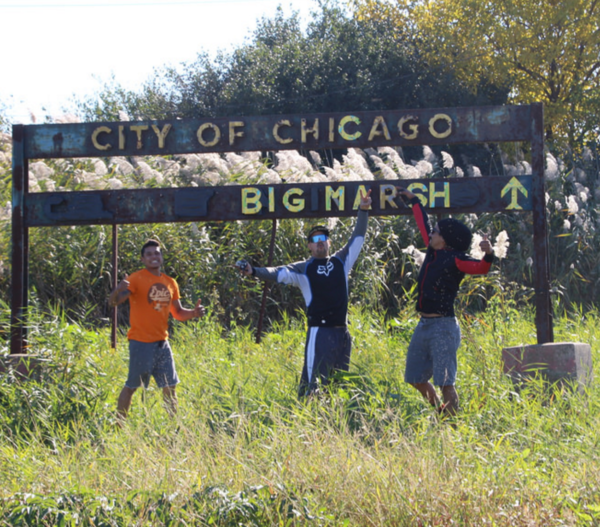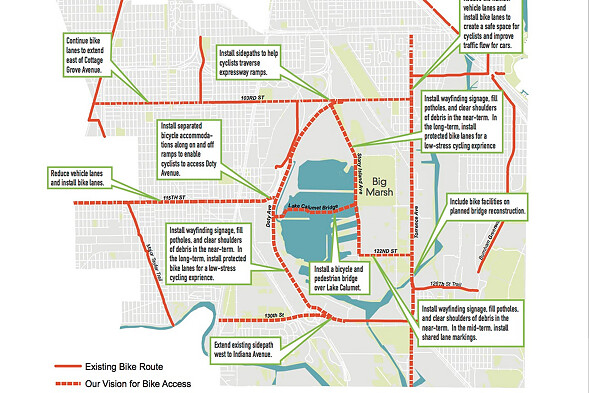[Last year the Chicago Reader launched a weekly transportation column written by Streetsblog Chicago editor John Greenfield. We syndicate a portion of the column on Streetsblog after it comes out online; you can read the remainder on the Reader’s website or in print.]
Last month, under sapphire skies and with temperatures in the upper 60s, more than 1,000 people turned out for the grand opening of Big Marsh, the 278-acre southeast-side nature reserve and bike park located on the east side of Lake Calumet. Mayor Rahm Emanuel, Chicago Park District superintendent Michael Kelly, and Tenth Ward alderman Susan Sadlowski Garza were there along with activists from Slow Roll Chicago, which promotes cycling in underserved communities, and We Keep You Rollin', an Altgeld Gardens-based bike group. After cutting the ribbon, Emanuel grabbed a bike and pedaled around the path that circles the "pump track," a series of dirt hills and jumps for BMX riders.
Cycling advocates are generally thrilled with Big Marsh—which will eventually include facilities for mountain biking, cyclocross, and casual trail riding—but have repeatedly expressed concerns about how dangerous it can be to ride to the park, because nearby roads have high-speed traffic and/or large numbers of trucks. (Big Marsh isn't directly accessible by public transit.)
Now, however, there's some good news on this front. At last week's Mayor's Bicycle Advisory Council meeting at City Hall, the Chicago Department of Transportation announced plans for bike lanes on some key roadways leading to the reserve.
Next year, buffered bike lanes will be installed on Cottage Grove Avenue between 93rd and 115th, a route that’s somewhat useful for cyclists approaching Big Marsh from the north. Then, in late 2017 or early 2018, Stony Island, which skirts the east side of Lake Calumet and provides the only direct access to reserve’s entrance, will get bike lanes between its intersection with Doty Avenue (on the west side of the lake), just south of 103rd, and 122nd, in conjunction with a repaving project. And as early as 2018, Torrence Avenue—part of the most direct routes to Big Marsh from the Altgeld Gardens area to the southwest and Hegewisch to the southeast—will get bike lanes between 100th and 126th.
CDOT is also planning to add bike lanes to the two-lane stretch of 103rd Street from Michigan Avenue west to Vincennes at a yet-to-be-determined date.
"[The bike-lane construction] is never as fast as anyone would like it to be," says CDOT staffer Mike Amsden, who manages the agency’s bikeway program. "But it is a priority for us."
During the meeting, Friends of Big Marsh director Jay Readey said that his group’s ultimate goal is to connect the four corners of the reserve to off-street paths such as the Major Taylor Trail, the Burnham Greenway, and the Cal-Sag Trail via safe routes.
One problem area, Ready noted, is the connection between the Pullman neighborhood and Doty. This requires cyclists to pedal up and down access ramps for I-94 at 111th or 115th in order to cross the highway. That's a dangerous—and technically illegal—maneuver.
"We've got to figure out some kind of protected-lane solution," Ready said.
Big Marsh was built on a former steel mill slag-dumping site. The roughly 44-acre bike park opened this year on the most heavily polluted portion of the property, and environmental remediation is still under way on the remaining 234 acres, a patchwork of open water, marshes, prairie, and woodland.
While Big Marsh is sure to attract cyclists and nature lovers from across the Chicago region and beyond, it's also intended as a recreational and educational resource for residents of nearby neighborhoods. These are mostly low-income African-American and Latino communities with low rates of car ownership.






